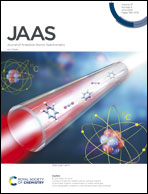Effects of argon on the analytical properties of a microwave-sustained, inductively coupled, atmospheric-pressure plasma†
Abstract
The effects of argon added to a high-power microwave-sustained, inductively coupled, atmospheric-pressure plasma (MICAP) initially operated with nitrogen as the sole plasma gas were investigated. While replacing nitrogen in the intermediate gas flow with argon had negligible effects on the emission signal intensities of 65 emission lines of 29 elements, 100% argon in the nebulizer gas flow resulted in a line-dependent signal suppression of up to 70%. Pure argon in both the intermediate and nebulizer gas flows and nitrogen in the outer gas flow interestingly resulted in a signal enhancement of up to 60% for high excitation energy atom and ion lines. Moreover, limits of detection determined with this gas composition showed an improvement exceeding a factor of two for Na(I) 588.995 nm, Na(I) 589.592 nm, Ni(II) 231.604 nm, Sb(I) 206.833 nm, and Sb(I) 217.581 nm. On the other hand, the addition of argon to the outer gas stream was found to be problematic: above an argon fraction of 71%, the initially diffuse plasma discharge filamented into a thin, highly luminous ring. The MICAP could not be operated under these conditions over a prolonged time due to the expansion of the plasma ring towards the quartz torch wall and subsequent damage of the torch (melting). Argon was found to constrict the plasma core when added to the intermediate or outer gas flow. This constriction was followed by a widening of the analyte channel and a general loss in analyte emission intensity. The effect was largest for a mixed gas plasma with an outer gas stream composed of 71% argon and 29% nitrogen, showing a 60% increase of the analyte channel cross section diameter and a line-dependent emission line signal loss of 20 to 50%. Moreover, no combination of nitrogen/argon in either gas flow was found to significantly reduce the highly structured nitrogen plasma background of the MICAP. High-speed imaging revealed that the filamented plasma discharge is composed of several small plasma segments that chaotically rotate around the center of the plasma torus resulting in what is perceived to be a thin, highly luminous ring.



 Please wait while we load your content...
Please wait while we load your content...